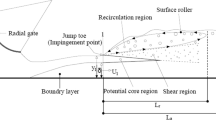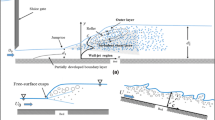Abstract
A hydraulic jump is characterized by strong energy dissipation and mixing, large-scale turbulence, air entrainment, waves, and spray. Despite recent pertinent studies, the interaction between air bubbles diffusion and momentum transfer is not completely understood. The objective of this paper is to present experimental results from new measurements performed in a rectangular horizontal flume with partially developed inflow conditions. The vertical distributions of the void fraction and the air bubbles count rate were recorded for inflow Froude number Fr 1 in the range from 5.2 to 14.3. Rapid detrainment process was observed near the jump toe, whereas the structure of the air diffusion layer was clearly observed over longer distances. These new data were compared with previous data generally collected at lower Froude numbers. The comparison demonstrated that, at a fixed distance from the jump toe, the maximum void fraction C max increases with the increasing Fr 1. The vertical locations of the maximum void fraction and bubble count rate were consistent with previous studies. Finally, an empirical correlation between the upper boundary of the air diffusion layer and the distance from the impingement point was derived.
Similar content being viewed by others
References
Rajaratnam N (1962) An experimental study of air entrainment characteristics of the hydraulic jump. J Inst Eng India 42(7):247–273
Thandaverwara BS (1974) Self aerated flow characteristics in developing zones and in hydraulic jumps. Ph.D Thesis, Dept. of Civil Engineering, Indian Institute of Science, Bangalore, India, 399pp
Resch FJ, Leutheusser HJ (1972) Le ressaut hydraulique: mesure de turbulence dans la region diphasique. La Houille Blanche 4:279–293 (in French)
Chanson H (1995) Air entrainment in two-dimensional turbulent shear flows with partially developed inflow conditions. Int J Multiphase Flow 21(6):1107–1121
Mossa M, Tolve U (1998) Flow visualization in bubbly two-phase hydraulics jump. J Fluids Eng ASME 120:160–165
Chanson H, Brattberg T (2000) Experimental study of the air-water shear flow in a hydraulic jump. Int J Multiphase Flow 26(4):583–607
Murzyn F, Mouaze D, Chaplin JR (2005) Optical fibre probe measurements of bubbly flow in hydraulic jumps. Int J Multiphase Flow 31(1):141–154
Babb AF, Aus HC (1981) Measurements of air in flowing water. J Hydraul Div ASCE 107(2): 1615–1630
Chanson H (1988) A study of air entrainment and aeration devices on a spillway model. Ph.D Thesis, Research Report No. 88–8, University of Canterbury, New Zealand, Oct., 239pp
Chanson H (1997) Air bubble entrainment in free-surface turbulent shear flows. Academic Press, London U.K., 401pp
Chanson H, Brattberg T (1998) Air entrainment by two-dimensional plunging jets: the impingement region and the very-near flow field. In: Proc. 1998 ASME fluids eng. conf., FEDSM98, Washington, DC, USA, June 21–25, paper FEDSM98–4806, pp. 8
Long D, Rajaratnam N, Steffler PM, Smy PR (1991) Structure of Flow in Hydraulic Jumps. J Hydraul Res IAHR 29(2):207–218
Habib E, Mossa M, Petrillo A (1994) Scour downstream of hydraulic jump. In: Proc. conf. modelling, testing & monitoring for hydro powerplants, Int. J. Hydropower & Dams, Budapest, Hungary, pp 591–602
Cummings PD, Chanson H (1997) Air entrainment in the developing flow region of plunging jets. Part 1 Theoretical development. J Fluids Eng Trans ASME 119(3):597–602
Cummings PD, Chanson H (1997) Air entrainment in the developing flow region of plunging jets. Part 1 experimental. J Fluids Eng Trans ASME 119(3):603–608
Cummings PD, Chanson H (1999) An experimental study of individual air bubble entrainment at a planar plunging jet. Chem Eng Res Design Trans IChemE Part A 77(A2):159–164
Clift R, Grace JR, Weber ME (1978) Bubbles, drops and particles. Academic Press, New York
Brattberg T, Chanson H (1998) Air entrapment and air bubble dispersion at two-dimensional plunging water jets. Chem Eng Sci 53(24):4113–4127
Chanson H (1989) Study of air entrainment and aeration devices. J Hydraul Res IAHR 27(3): 301–319
Chanson H, Aoki S, Hoque A (2004) Physical modelling and similitude of air bubble entrainment at vertical circular plunging jets. Cheml Eng Sci 59(4):747–754
Author information
Authors and Affiliations
Corresponding author
Rights and permissions
About this article
Cite this article
Gualtieri, C., Chanson, H. Experimental analysis of Froude number effect on air entrainment in the hydraulic jump. Environ Fluid Mech 7, 217–238 (2007). https://doi.org/10.1007/s10652-006-9016-1
Received:
Accepted:
Published:
Issue Date:
DOI: https://doi.org/10.1007/s10652-006-9016-1




